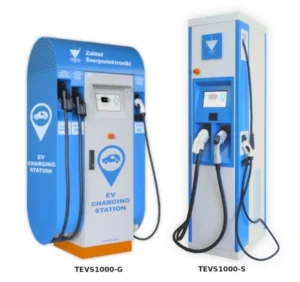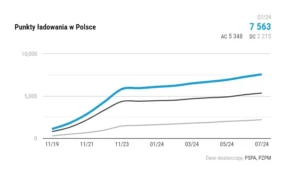The world is rapidly moving towards decarbonization and the abandonment of fossil fuels. In particular, the European Green Deal assumes a reduction in greenhouse gas emissions from transport by… 90% by 2050. Meanwhile, the RED III Directive introduces an ambitious goal of achieving at least a 29% share of renewable energy in total energy consumption in transport by 2030.
However, such ambitious projects come with a number of challenges that need to be efficiently managed using available technologies and resources. It also seems that decision-making bodies are somewhat sluggish, and one can sense limited technological competencies or simply not very strong skills in proper calculation and estimation of the feasibility of the assumptions adopted in the plans.
One way to achieve decarbonization is the development of the private electric transport market, i.e., widespread electromobility. There are strategic, scientifically grounded comments regarding the environmental friendliness of the production and use of electric vehicles. On the other hand, there are also many justified concerns about the production of traction batteries, the chemistry of their components, and the complex process of their disposal or recycling.
However, the lack of proper infrastructure and the wrong approach to its development remain the biggest challenge for electromobility in Poland and Europe.
Year by year, the number of charging stations is growing dynamically, and access to them is becoming increasingly easier. Special programs encouraging the purchase of electric vehicles are being introduced, financed from various funds. Let us remember that this is still the beginning of the road towards electromobility, and several challenges lie ahead.

TEVS1000 enables fast charging of electric vehicles with direct current (DC) via CCS or CHAdeMO connectors and alternating current (AC) via a type 2 connector. Charging power: DC 60 kW, AC 22 kW.
Software deficiencies
The pace of growth in the number of electric vehicles increases year by year, and the number of charging stations in cities and on highways is also growing. According to experts, by the end of 2024, the number of stations put into operation in Poland may reach 10,000, and by the end of 2027 over 35,000.

Source: https://psnm.org/research/licznik-elektromobilnosci/
This is quite an impressive number, which reflects the pace of industry development. However, several problems can be observed with such dynamic growth: imperfections in execution and applied components, but also concerning quality of the software supporting usage.
While traveling across Poland, electric vehicle owners face the same challenges, regardless of the station operator:
- The presence of a station in a mobile app and on the map does not mean it will be operational or connected to the network.
- If the station is working, the probability of the following problems remains high:
- no communication with the electric vehicle;
- no communication between the station and the server;
- problems with remote charging via the mobile app.
Unpreparedness of the power grid
Unfortunately, in Poland, as in most European countries facing the energy transition, too little emphasis is still placed on rebuilding and developing power grids. One electric car can consume over 50 kW of electricity during charging. This means that simultaneous charging of even 5,000 electric vehicles can cause an additional network load of 250 MW, resulting in unpleasant fluctuations in the National Power System.
Just like with conventional petrol stations, the load on charging stations is not evenly distributed throughout the day. There are peak hours and periods of low demand. Such fluctuations, along with the chaotic development of infrastructure for small home photovoltaic power plants with unstable generation, have the greatest impact on the destabilization of the energy system as a whole.
As we know, further uncontrolled development of the situation may lead to serious consequences for power distribution devices, and the likelihood of failures in the network increases significantly.
At the same time, the modern market, apart from increasing the number of stations, has launched a real race for the maximum charging power. Not long ago, 50 kW stations dominated, but now we hear more and more about the growing demand for 120–180 kW stations. It is worth noting that at the moment these are simply wasted funds, because the current grid barely handles a 50 kW load. Such solutions are also harmful to the grid and may significantly contribute to its further destabilization.

EVC1000 — is a safe, high-quality module intended for use in DC fast-charging stations for electric vehicles (EV).
Business plan for the charging station owner
Let us now take a look at the current situation in the charging station operators’ market and the costs borne by electric vehicle owners.
Necessary investments to open a new charging station, considering the previously mentioned technical problems, include:
- Purchase of the charging station
- Development of an app for station management, operation monitoring, and payment systems
- Development of the installation project with subsequent approval, installation, testing, and commissioning
- Payments of fixed rents, leases, and other fees to relevant authorities
- Expenditures on station and server equipment maintenance
- Payment for consumed electricity.
Let us then calculate the return on the project with a price of PLN 3 per 1 kWh for a single station.
The cost of purchasing a 50 kW station is approximately PLN 64,000. This means it is the price of the equipment itself, excluding the costs of points 2–5, which may vary depending on network parameters and business model.
The electricity supplier’s fee is from PLN 1.4 per kWh.
Let’s assume that the minimum profit from the activity is 10% (i.e., PLN 0.3). This means that PLN 1.3 is the amount that the owner can theoretically allocate for the repayment of the initial investment and the associated charging station costs.
At the same time, it must be understood that the depreciation rate of the equipment is about 20%. Consequently, the book value of the device after 5 years of use will be close to zero, and maintenance costs may amount to 5–10% of the value, i.e., around PLN 6,400 per year (at a price of PLN 64,000). As a result, with full depreciation over 5 years, the owner incurs additional costs of PLN 35,000.
The total cost of the station over 5 years will realistically amount to PLN 99,000. In other words, the station’s payback period corresponds to the consumption of 76,153 kWh of energy by vehicles. This means that during operation at full 50 kW load (which is quite rare), 1,523 hours of operation are needed for the station to pay off.
As a manufacturer of fast charging stations, we constantly monitor their operation and can state that the average daily operation time does not exceed 4 hours (or 5 charging sessions), and in some locations, it is only 6 hours per week.
Therefore, considering this level of workload, the return on investment ranges from 1.5 years to 3 years. If we take into account the total investment needed to launch a single station, the payback period may be as long as 5 years, which is the time after which the installation likely requires replacement or repair.
And what does the EV owner get out of it?
Let’s now take a look at what the costs of owning an electric vehicle (EV) look like from the owner’s perspective.
First of all, the cost of an electric car is 30–50% higher than that of a comparable gasoline or diesel vehicle. One example is the Volvo XC40 Recharge, which sells for around PLN 230,000, whereas its gasoline counterpart, the Volvo XC40 B3, is priced at approximately PLN 160,000. This means that the internal combustion engine (ICE) vehicle is PLN 70,000 cheaper than its electric equivalent. Translated into traditional fuel costs, this equals about 10,000 liters of gasoline — or around 100,000 kilometers (the average distance driven in 3 years), assuming fuel consumption of 10 liters per 100 km.
Secondly, the average energy consumption of an electric car is 25 kWh per 100 km. This means that a 500 km trip at a price of PLN 3/kWh costs about PLN 375 (equivalent to the cost of 53 liters of gasoline). Of course, different vehicles vary in fuel efficiency, but the cost of charging an EV is quite comparable to, and sometimes even higher than, the cost of fueling a car with an internal combustion engine — especially since modern ICE engines can consume as little as 4 liters per 100 km.
Thirdly, the service and maintenance costs of electric and ICE vehicles do not differ significantly over the first 3–5 years. As a result, an ICE vehicle owner could realistically drive for 3 years without incurring additional costs. The initial expenses are comparable to those of an electric vehicle in the same class.
So, what does this simple calculation reveal? It paints a picture of a somewhat irrational investment in green technology.
The conclusions drawn from this analysis highlight several key issues that both charging station owners and EV users should take into account.
Firstly, the return on investment (ROI) for a charging station may be significantly longer than it initially appears, due to operational factors such as low station usage and the need for regular maintenance and repairs.
Secondly, for the EV owner, the costs associated with using the vehicle may be comparable to — or even higher than — those of ICE vehicles, which challenges the notion that EVs are clearly more cost-effective.
In summary, the current market conditions — for both charging station operators and EV owners — may cast doubt on the actual benefits of investing in green technology. The final decision should be based on a clear understanding of long-term costs, expected station utilization, evolving energy prices, and technological progress.
Should we give up?
First and foremost, we should remember that internal combustion engine vehicles faced similar issues over 100 years ago. Back then, cars were astronomically expensive, costly to maintain, and lacked basic infrastructure like fuel stations. Not to mention that roads were often unsuitable for this new mode of transport — after all, the asphalt road network developed thanks to the car.
We all know that cars have become an indispensable part of our lives. It’s hard to imagine a world without our daily reliance on four wheels. The challenge ahead is not to abandon mass mobility, but to change the power source — to one that reduces emissions and frees us from dependence on unstable fossil fuel–producing countries.
The current issues facing the EV market do not mean we’ve reached a dead end. What’s needed is a systemic approach to solving these individual problems. Poland is not an exception — most countries advancing in electric transportation are facing the same challenges.
The latest directives from the Council of Europe are already working toward eliminating the need for mobile apps or user registration during charging. They also aim to standardize charging requirements for both car manufacturers and charger producers.
At the same time, most tech giants are working intensively on innovative methods of energy efficiency and optimization. New chemical compounds are being developed and tested to accelerate the transition away from lithium-based traction batteries.
The world has already made the ecological choice. Now it’s all up to technological development — and sensible decisions by planners and policymakers.
The article was written by Oleksandr Skliar,
Development Director at TWERD ENERGO-PLUS Ltd. (https://twerd.pl/)
The publication is a result of cooperation between TWERD ENERGO-PLUS Ltd. and enerad.pl